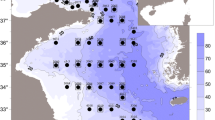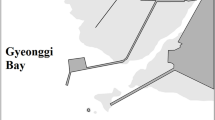Abstract
The macrobenthos (>1.0 mm) in the Calvert Cliffs region of the Chesapeake Bay was sampled over a three year period (1971–1974). Four distinct communities (shell, 3 m sand, 6 m muddy-sand, 9 m mud) were identified and described using single-linkage cluster and discriminant analyses. Substrate characteristics were the major environmental factor controlling the spatial distribution of macrobenthic communities within the study area, and within a habitat communities were relatively homogeneous throughout the region. The structure of the 6 m muddy-sand community variously resembled the 3 m sand or the 9-m mud community depending upon season and year.
Similar content being viewed by others
Literature Cited
Boesch, D. F.. 1973. Classification and community structure of macrobenthos in Hampton Roads area, Virginia.Mar. Biol. 21:226–244.
— 1974. Diversity, stability and response to human disturbances in estuarine ecosystems, p. 109–114.In Proceedings of the First International Congress of Ecology, Wageningen: Centre for Agricultural Publishing and Documentation.
—. 1977. A new look at the distribution of benthos along the estuarine gradient, p. 245–266.In B. C. Coull (ed.), Ecology of marine benthos, No. 6. Belle W. Baruch Library in Marine Science, Columbia, S. C., Univ. of South Carolina Press.
Buchanan, J. B., andJ. M. Kain. 1971. Measurement of the physical and chemical environment, p. 30–58.In N. A. Holme and A. D. McIntyre (eds.) Methods for study of marine benthos. I.B.P. Handbook No. 16, Blackwell Scientific Publications Oxford.
Cargo, D. G., and J. A. Hunt. 1974. Cove Point benthic study. C.E.E.S. Ref. No. 75-17.
Connell, J. H.. 1971. The influence of interspecific competition and other factors on the distribution of the barnacle,Chthamalus stellatus.Ecology 42:710–723.
Copeland, B. J.. 1970. Estuarine classification and responses to disturbances.Trans. Amer. Fish. Soc. 99:826–835.
Dickson, J. J., andA. G. Carey. 1975. A comparison of two benthic infaunal samplers.Limnol & Oceanogr. 20:900–901.
Fager, E. W.. 1957. Determination and analysis of recurrent groups.Ecology 38:586–595.
Gage, J. D.. 1975. A comparison of the deep-sea epibenthic sledge and anchor-box dredge samplers with the van Veen grab and hand coring by diver.Deep-Sea Res. 22:693–702.
Grassle, J. F., andJ. P. Grassle. 1974. Opportunistic life histories and genetic systems in marine benthic polychaetes.J. Mar. Res. 32:253–284.
Hamilton, D. H., and R. S. LaPlante. 1972. Cove Point benthic study (annual report), Natural Resources Institute Reference No. 12-36, 66p.
Holland, A. F. 1976 Analysis and evaluation of preoperational benthic data at Calvert Cliffs (June 1971–February 1974). Maryland Power Plant Siting Program Report No. CC-76-1, 80 p.
—, andJ. M. Dean. 1977. The community biology of intertidal macrofaunal sandbars in the North Inlet area of South Carolina, U. S. A., p. 423–438In B. C. Coull (ed.) Ecology of marine benthos, No. 6, Belle W. Baruch Library in Marine Science, Columbia, S. C., Univ. of South Carolina Press.
Lachenbruch, P. A.. 1975. Discriminant analysis. 128 pp. Hafner Press, New York.
Lippson, A. J.. 1973. The Chesapeake Bay in Maryland—an atlas of natural resources. The Johns Hopkins University Press, Baltimore, Maryland. 55 p.
Mills, E. L.. 1969. The community concept in marine zoology, with comments on continua and instability in some marine communities.J. Fish. Res. Board Can. 26:1415–1428.
Obremski, H. 1974. Analysis of Calvert Cliffs reference station measurements (temperature, salinity, and dissolved oxygen). Maryland Power Plant Siting Program Report No. PPSP-MP-10, 37 p.
Orluci, L.. 1967. An agglomerative method for classification of plant communities.J. Ecol. 55:193–206.
Parker, R. H.. 1964. Zoogeography and ecology of some macroinvertebrates, particularly mollusks, in the Gulf of California and the continental slope off Mexico.Vidensk. Med. Dansk. Naturh. Foren. 126:1–178.
Pfitzenmeyer, H. T.. 1970. Gross physical and biological effects of overboard spoil disposal in upper Chesapeake Bay. N. R. I., Univ. of Maryland, Spec., Rept. No 3, pp. 26–38.
Pfitzenmeyer, H. T. 1973. Benthos of Maryland waters in and near C and D canal.In Hydrographic and ecological effects of enlargement of the Chesapeake and Delaware canal. 41 p. N.R.I. Ref. No. 73-113.
Pielou, E. C.. 1966. The measurement of diversity in different types of biological collections.J. Theor. Biol. 13:131–144.
—. 1969. An introduction to mathematical ecology. Wiley-Interscience, New York, 286 pp.
Polgar, T.. 1975. Characterization of benthic community responses to environmental variations by multiple discriminant analysis, p. 267–293.In S. B. Saila (ed.) Fisheries and energy production. Lexington Books, D. C. Heath and Co., Lexington, Massachusetts.
Rhoads, D. C. 1974. Organism-sediment relations on the muddy sea floor.Oceanogr. Mar. Biol. Ann. Rev. 12:263–300.
—. 1970. The influence of deposit feeding organisms on sediment stability and community trophic structure.J. Mar. Res. 28:150–178.
Sanders, H. L.. 1956. Oceanography of Long Island Sound, 1952–1954. X. Biology of marine bottom communities.Bull. Bingham Oceanogr. Coll. 15:345–414.
—. 1958. Benthic studies in Buzzards Bay. I. Animal-sediment relationships.Limnol. Oceanogr. 3:245–258.
—. 1960. Benthic studies in Buzzards Bay. III. The structure of the soft-bottom community.Limnol. Oceanogr. 5:138–153.
—,P. C. Mangelsdorf Jr., andG. R. Hampson. 1965. Salinity and faunal distribution in the Pocasset River, Massachusetts.Limnol. Oceanogr. Suppl., 10:4216-R229.
Seitz, R.C. 1971. Temperature and salinity distribution in vertical sections along the longitudinal axis and across the entrance of the Chesapeake Bay (April 1968 to March 1969), Graphical Summary No. 5, C.B.I. Ref. 71-1, 99p.
Sheppard T. Powell Associates, 1969–1972. Temperature-salinity-dissolved oxygen surveys of the Chesapeake Bay near Calvert Cliffs. Summer 1969–1972. Reports to: Baltimore Gas and Electric Company.
Stephenson, W., W. T. Williams, andG. N. Lance. 1972. The macrobenthos of Moreton Bay.Ecol. Monogr. 40:459–494.
Tenore, K. R.. 1972. Macrobenthos of the Pamlico River estuary, North Carolina.Ecol. Monogr. 42:51–69.
Thorson, G.. 1966. Some factors influencing the recruitment and establishment of marine benthic communities.Neth. J. Sea Res. 3:267–293.
Woodin, S. A.. 1974. Polychaete abundance patterns in a marine soft-sediment environment: the importance of biological interactions.Ecolog. Monogr. 44: 2, Spring 1974.
Young, D. K., andD. C. Rhoads. 1971. Animal-sediment relations in Cape Cod Bay, Massachusetts. I. A transect study.Mar. Biol. 11:242–254.
Author information
Authors and Affiliations
Additional information
Contribution No. 733, Center for Environmental and Estuarine Studies, University of Maryland.
An erratum to this article is available at http://dx.doi.org/10.2307/1351610.
Rights and permissions
About this article
Cite this article
Mountford, N.K., Holland, A.F. & Mihursky, J.A. Identification and description of macrobenthic communities in the Calvert Cliffs region of the Chesapeake Bay. Chesapeake Science 18, 360–369 (1977). https://doi.org/10.2307/1350591
Issue Date:
DOI: https://doi.org/10.2307/1350591




